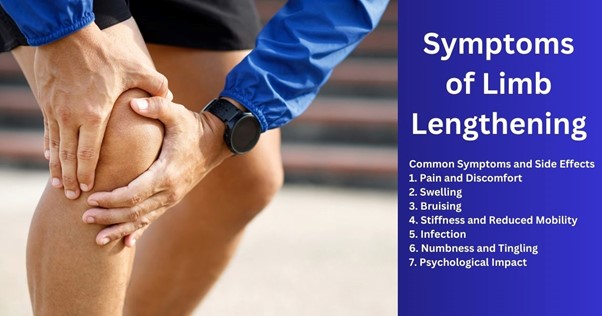- Address: D-30, Sushant Lok III, Sector 57, Gurugram
- [email protected]
- Phone: +91 9971119604

Limb lengthening is a remarkable surgical procedure that allows individuals to increase the length of their limbs, whether for medical reasons, such as correcting discrepancies in limb length, or for aesthetic and personal preference. As with any major surgical procedure, understanding the symptoms and potential side effects is crucial for anyone considering this path. In this blog post, we’ll delve into the various symptoms and experiences associated with limb lengthening, giving you a comprehensive overview of what to expect before, during, and after the procedure.
Limb lengthening involves a surgical technique designed to gradually increase the length of a bone. The process typically uses an external or internal fixator—a device attached to the bone—through which controlled amounts of distraction (lengthening) are applied over time. This is followed by a period of consolidation where new bone forms to fill the gap created by the distraction.
Pain and Discomfort
Description: Post-operative pain is a common symptom after limb lengthening surgery. Pain levels can vary, but it's usually manageable with prescribed pain medications.
Why It Occurs: The surgery involves cutting the bone and attaching an external or internal device. The body’s response to this procedure includes inflammation and discomfort.
Management: Pain is typically controlled with medications like opioids or non-steroidal anti-inflammatory drugs (NSAIDs). Physical therapy and proper post-operative care can also help manage discomfort.
Swelling
Description: Swelling around the surgical site and throughout the limb is expected. This can be quite pronounced in the initial weeks following surgery.
Why It Occurs: Swelling is a natural response to surgical trauma and is a part of the body’s healing process.
Management: Elevating the limb, applying ice packs, and following post-operative care instructions can help reduce swelling. Your surgeon will provide guidance on how to manage this symptom effectively.
Bruising
Description: Bruising around the area of surgery is common and can extend to adjacent areas of the limb.
Why It Occurs: Bruising happens due to the disruption of blood vessels during surgery.
Management: Bruising will generally resolve on its own. However, keeping the limb elevated and using ice packs can help alleviate some of the discomfort.
Stiffness and Reduced Mobility
Description: Stiffness in the limb and reduced mobility are frequent symptoms due to the surgical procedure and the immobilization of the limb.
Why It Occurs: The fixation devices and the healing process can limit movement and cause stiffness.
Management: Physical therapy is crucial for regaining range of motion and strength. Your therapist will guide you through exercises to improve flexibility and mobility.
Infection
Description: Infection at the surgical site is a serious but manageable risk.
Why It Occurs: Any surgery poses a risk of infection, particularly when there are open wounds or external devices.
Management: Maintaining good hygiene, following post-operative care instructions, and promptly reporting any signs of infection (such as increased redness, warmth, or discharge) to your surgeon are essential steps. Antibiotics may be prescribed to prevent or treat infections.
Numbness and Tingling
Description: Some patients experience numbness or tingling in the limb.
Why It Occurs: This can result from nerve irritation or compression due to the surgery or the fixation device.
Management: Numbness and tingling often improve over time, but persistent symptoms should be discussed with your surgeon to rule out any complications.
Psychological Impact
Description: The emotional and psychological toll of undergoing limb lengthening surgery can be significant.
Why It Occurs: The process is lengthy and involves a considerable amount of discomfort and lifestyle adjustment.
Management: Support from family, friends, and mental health professionals can help. Counseling or support groups may also be beneficial in managing the psychological aspects of recovery.
Limb lengthening is a transformative procedure that can significantly impact an individual’s life. While the symptoms and side effects are a natural part of the process, proper management and adherence to medical advice can help minimize discomfort and ensure a successful outcome. If you are considering limb lengthening surgery, make sure to have a detailed discussion with your orthopedic surgeon about the potential symptoms, recovery process, and long-term implications. Understanding what to expect can help you better prepare for the journey ahead and achieve the best possible results.